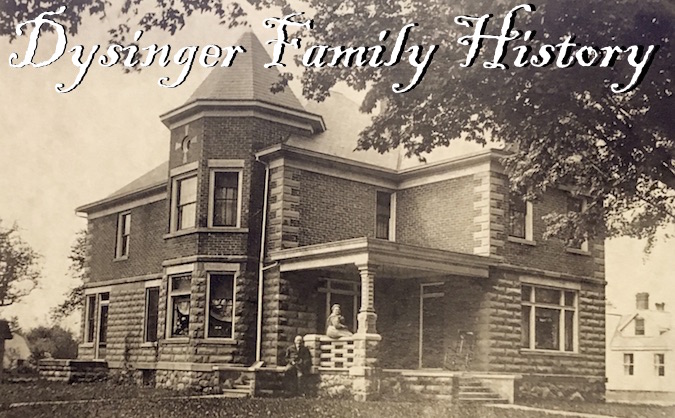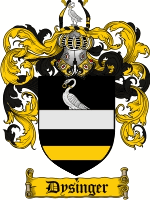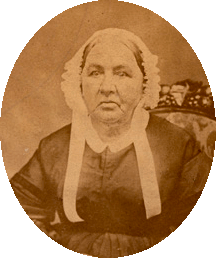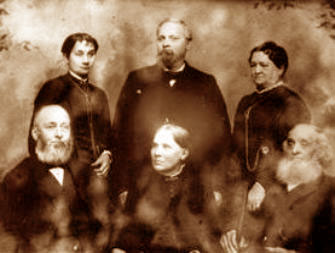 |
 |
This Dysinger (also spelled "Deissinger" or "Disinger") family can be traced back to BARTHEL DEISSINGER, born in 1681 in the Palatinate of Germany. On 19 Jun 1725, at the age of 44, Barthel married his second wife, ANNA BARBARA BERNHARD in Steinwenden, Freiburg, Baden-Wuerttemberg. She was the daughter of PETER BERNHARD of (6760) Bisterscheld, about 15 miles northwest of Steinwenden. Over the course of his two marriages, Barthel had sixteen kids! But it was only one son, HEINRICH ERASMUS DEISSINGER (b. 12 Jan 1730) who emigrated to Colonial America with Barthel on the Ship Patience, that we will follow.
They arrived on 16 Sep 1748, out of Rotterdam, Holland, via Cowes, Isle of Wight, England. (List 122 C at the Courthouse at Philadelphia.) In the records of the courthouse in Philadelphia, "Barthel Deising"[er], age 66, and "Hendk Deissinger," age 18, took their the Oaths to the British Government that same day they landed. Barthel then lived over 20 years in America, eventually passing away in 1770 in Lancaster, Pennsylvania. Meanwhile, Heinrich married MARIA CATHARINA MAYER (1734 - 1766), and had the following children:
CHILDREN OF HEINRICH AND MARIA CATHERINA DYSINGER |
|
|
|
|
|
|
|
|
Heinrich died on 18 Jan 1814 in Lancaster, Pennsylvania. But not before his son JOHANNES NICOL "NICHOLAS" DYSINGER (2 Mar 1755 - 1 Jun 1841) married EVA CATHERINE WEISNER (1756 - 5 Dec 1844) in Berks County, Pennsylvania, on 26 Apr 1779. During the American Revolution, Johannes Nicol served as a Corporal in Caption Conrad Shirman's Company, Sixth Battalion, Berks County Militia in 1780. He was called up again briefly from 10 Aug 1780 to 9 Sep 1780 "to fight the Indians."¹ Nicolaus was a corporal in Captain Conrad Shirman's Co, 6th Battalion, Berks County Militia (Joseph Hiester, Colonel). In 1780, the company was called into active duty against the Indians for 2 months (Aug 10 to Sep 9).
Nicolaus was spoken of as a "smith" and was a small taxpayer in Tulpehocken in 1780 and 1781. He did not own any land at that time, but in 1781 he had 1 cow. His name disappears from the tax rolls in 1785. Based on birth records of his children, he left Tulpehocken after 1783. Searching for new opportunities, Nicholas and his family moved to Cumberland County, Pennsylvania, some time after 1784, and then to Franklin County (now part of Cumberland). About 1792 or 1793, they moved to Perry area of Cumberland County (now called Perry Co.), where he owned 2 adjacent farms in the Sherman Valley. After the War of 1812, Nicolaus and his son George sold their farms and moved to Seneca County, New York. Sons John and Thomas had previously moved to Seneca County, and the family was reunited.
Nicholas and his family moved to the town of Fayette in Seneca Co, New York in 1813. His first purchase was of 20 acres of land on 13 May 1815. Nicholas was a shrewd, ambitious investor, and eventually his family maintained hundreds of acres along Cayuga Lake, near "Hause Point," the farm of the JOHN HAUSE family. The children of Nicholas and Eva Catherine Dysinger were:
CHILDREN OF JOHAN NICHOL AND EVA CATHERINE DYSINGER |
|
|
|
|
|
|
|
|
|
|
|
|
|
|
|
|

|
Niagara County had been until the nineteenth century a vast wilderness, except for Indians living in the woods and some British forts and loyalist settlements along the Niagara River. Then in 1797 the Indians' claim to the land was extinguished for a fee of... well, next to nothing, and they were forced to leave. In 1808 the county of Niagara was created, and the Indian trails were improved to handle the ox carts and eventually Connestoga Wagons drawn by four to six horses could traverse the woods. Then in 1817 the construction of the Erie Canal began, and suddenly new residents poured in.
The Erie Canal linked the waters of Lake Erie in the west to the Hudson River in the east, and opened the country west of the Appalachian Mountains to settlers, and offered a cheap and safe way to carry produce to a market. The effect on the economy and industry in the United States was staggering. Cargo that had taken two weeks to carry by road could now be moved in three and a half days. Farmers now could sell flour back east for a living, as freight rates for their products that had cost $100 a ton by land could be shipped by Canal for eight to ten dollars per ton.
In the Spring of 1828, the David Dysinger family emigrated to Niagara County, with five kids and all of their personal property packed in a covered wagon with a four-horse team. The journey from Pennsylvania—about 500 miles—took about 14 days. His son Henry, then seven years old, would later recall that while fording the streams, the water would be up his knees while on the lead horse, and one false step would have engulfed horse, rider and wagon.
They settled in what is now Lockport, building a log house and stable in the dense wilderness. With two cows, three pigs and a very small patch of wheat and corn, they battled the elements and malaria... and then added six more kids!
CHILDREN OF DAVID DYSINGER AND CATHERINE ERNEST |
|
|
|
|
|
|
|
|
|
|
|
|
|
|
|
|
|
|
|
|
|
|
|
 Children of George and Elizabeth Deissinger, in Lockport New York: Front Row, Left to Right: Benjamin Disinger 1816-1894, Lydia Disinger Behe 1819-1904 John Disinger 1809-1878 (oldest). Back Row, Left to Right: Sarah Disinger Zachariah 1837-1900; William Disinger 1832-1916; Elizabeth Disinger Ernest 1823-1887. Children not in picture: Albert Nicholas Disinger 1830-1908; Andrew Disinger 1835-1905; Daniel Disinger 1828-1896; Issac Disinger 1826-1886; David Disinger; & Jacob Disinger. |
Unlike the hilly "Finger Lakes" region of Seneca County, which was known more for wines than wheat, Niagara County was flatter and green, and ideal for raising animals and grains. And with scores of new customers flowing through the region by way of the Erie Canal to open new markets for crops in the north.
George's original home was a log cabin now at the intersection of Bunker Hill and Akron Roads on the north side of Bunker Hill Road. He later built the stone house (still standing 2010) east of this log cabin and west of the intersection of Gasport and Bunker Hill Roads. On the west front corner of this house is a large stone, at eave level, stating "GD 1842." It is said that in the early days, this house served as a tavern. The original log cabin was destroyed in the 1930's when Akron Road was improved. (The road was widened and large curves added.)³
The Dysingers brothers flourished in Niagara County, both in family and in finance. The area where George lived came to be known as Dysingers Corners, and soon a post office and church were added.
George sent word back to his relations in Seneca County of his good fortune, and soon his former neighbor in Fayette, AUGUSTUS HAUSE, son of John, arrived to purchase over 150 acres of property near George's farm.
The George Dysinger and Augustus Hause families may have been close, but Augustus' sons were more interested in David Dysinger's family in Lockport—more to the point, they were interested in the daughters of David Sanderson of Lockport. On September 20, 1854, LABAN HAUSE married SARAH DYSINGER (24 Oct. 1832 - 16 March 1859), in the town of Lockport. Laban's brother, JOHN J. HAUSE, married a daughter, as well—named CATHERINE EAVE DYSINGER (23 Aug 1830 - 1926).
 The Hause brothers reunite in Royalton in the late 1800's. Back Row: Augustus Hause, Jr., Laban A. Hause, and John J. Hause. Middle Row: Hannah Grove-Hause, Melissa Sanderson Hause, Catherine Eave Dysinger-Hause. Front Row: Unknown, Elma Hause (daughter of Laban and Sarah Dysinger-Hause). |
|
||||||||||||||||||||||||||||||
Laban and Sarah then sold 100 acres of property in Lockport that she had inherited from her late father, for $500. The document was signed by Sarah's mother, Catharine, and accepted by Laban "House" and Sarah in St. Clair county, Michigan. (On the next page in the book of deeds, Catherine sold more of the Lockport land willed to her other children, including John and Eve Dysinger-Hause.)⁴
Two years later, Laban and Sarah had a child:
CHILDREN OF LABAN AUGUSTUS HAUSE AND SARAH DYSINGER |
|
|
But Sarah developed complications after the birth, and became sick. She lingered for two more years before finally passing away on March 16, 1859.
Laban was not prepared to raise an infant daughter by himself in the wilds of Michigan. His sister, Basheba Hause-Oakes, and brother John had settled nearby and probably helped with Elma, but Laban needed a more permanent solution. While John and Catherine Eave Hause returned to Royalton, Laban remained and remarried. Eventually he sold the Riley Center farm to Daniel's son, HENRY E. DYSINGER (b. 1858), and moved into the town of Memphis, St. Clair Co., Michigan. Daniel passed away in 1898, and is buried in the Memphis Cemetery, as are Laban and Sarah.
TOP PHOTO: A 1913 photo of The "Dysinger Place" in Memphis, owned by Daniel Franklin Dysinger, Jr. (26 Aug 1853 - 20 Feb 1923) and his wife, Ida Belle Nye (29 Feb 1856 - 27 Mar 1938). Daniel was born at Dysinger's Corner in Royalton, New York and moved out to Michigan as an infant with his parents. Ida Belle lived her entire life oin the Memphis area. They bought the lot for the house when it was just a vacant lot on Maple Street. It is said Ida wanted to have the most impressive house in the village, and she got it. In 1925 it became the parsonage for the Memphis First United Methodist Church, which is next door to the property.
NOTES ON THIS PAGE:
¹—A biographical sketch written of him for the first Deissinger/Disinger/Dysinger Reunion in 1901 by Lyman Dysinger: The earliest ancestor that we have any account of is Nicholas Dysinger, who was born in the year of 1753 and died in the year 1840 in the town of Fayette, Seneca Co. N.Y. at the age of 87. He was buried in the Cemetery connected with the Dutch Reformed Church and Beary-town in the town of Fayette N.Y.
He was a farmer by occupation and removed in 1825 from Cumberland Co. Penn. to Seneca Co. N.Y. and continued to live in the latter Co. until the time of his death. With his two brothers John & William he served on the side of the colonists in the American Revolution.
Nicholas left a family of seven children, John, George, David, Thomas, Barbara Ann, Susan and Catherine. The three daughters removed from this part of the State, and as near as we can learn, from the State of New York. We are not able to give any account of their families.
Thomas, George and David moved to Niagara Co. N.Y. and there founded and left families. John Dysinger was born in Cumberland Co., Penn., January 1, 1782 and came to Seneca Co. in 1804 and lived there until the time of his death on June 8, 1869, at the age of 87 years.
In 1806 John married Elizabeth Ernsberger from Cumberland Co. Penn., and the result of this marriage was a family consisting of seven children, five boys and two girls, as follows: Nicholas, Nancy, Betsey, John, Jacob, Daniel & Samuel, of whom but two are living at this time, namely; Daniel & Samuel, both of whom are living in the town of Fayette, Seneca Co. N.Y.
John Dysinger was one of the early pioneers and settled in Seneca Co. When he came to this county he walked from his native home in Penn. and brought all his worldly possessions in a bag upon his shoulders.
He first stopped at the McAllister farm (now the Martin L. Allen farm) in Fayette and worked a week for an axe. Having thus earned and procured this necessary tool, he went into the forest southwest from where is now the Burgh Church and built him a hut, which became his home and habitation. While he was living in this log house his brother Thomas came on from Penn. and lived with him for a while, but afterwards went on west to Niagara Co..
John Dysinger was an industrious and frugal man who was so mindful of his own business and so unmindful of the business of his neighbors that he never sued or never was sued in his life. His frugality and industry brought him what was considered wealth in those days, and he became in time the owner of about five hundred acres of good farming lands in Seneca Co. One of the pronounced features of his life was his unyielding and extreme opposition to the Erie Canal at the time that great water highway was being built through the State. He expressed himself all times and upon all occasions in the strongest language he could command against the project. His chief arguments with the farmers were that it would render transportation so much easier that "hosses" would become of little or no value. He often said that he would contribute his whole grain crop in any one year to feed the muskrats to give strength to dig as many holes in the bottom of the canal that it never would hold water.
The following facts show the present situation of the family of John Dysinger so far as we all are able to record it at this time. Nicholas died at the age of 12 years. Nancy married Michael Hoster and both are dead, leaving six children, fourteen grand-children and four great grand-children. Betsey married John Frantz both of whom are now dead. They left six children, seven grandchildren and nine great grandchildren. John married Caroline Yost, he is dead, she is now living with her son, Lyman Dicinger. They left a family of four children, seven grand-children and one great grand-child. Jacob married Mary Granbee for his first wife and they left two children, twelve grand-children and 5 great grand-children. After her death he married another Mary Granbee and the result of this marriage was no child. Daniel & Samuel were still living as before mentioned. Daniel was twice married. His first wife was Catherine Esshnour by whom he had one child, and his second wife was Christinana Schroyer by whom he has three children and three grand-children. Samuel married Caroline Bookman and they have five children, two grand-children and two great grand-children. A summary of the decedents shows seven children, twenty-eight grand-children, fifty great grand-children and fourteen great great grand-children.
²—Research by Stephen A. Dysinger, grandson of David Dysinger. Stephen's father was Henry Dysinger (1821- 1890): "In the Spring of 1813, our grandfather, then a young man of 22, enlisted in the Army in Pennsylvania and was detailed to duty on the Niagara Frontier, then a scene of great activity in the warfare between the mother country and our own.
Whether he was engaged in any of the battles that have rendered the mighty river historical, as well as wonderful, our records and researches fail to disclose, but his courage and ability to fight had the opportunity presented are unquestioned by those who knew him.
Only one incident of this campaign has been related to me. He with ten or twelve companions became separated from their company and after wandering about for nearly a day in the dense forest without food came upon a small clearing in the center of which stood a rude log house.
Tired and nearly starved, they applied at the place for food. The lady of the house recognizing them as friends told them she had nothing in the house to eat but said she was then mixing bread to which they were welcome if they could wait until it was baked. Hungry and tired they waited until the bread was baked and then began the feast of their lives on the hot bread.
Three of their number became desperately sick on the new hot bread and died there in a short time, and were buried there by their companions who shortly regained their camp and company. Attracted by the beautiful country and the fertility of the soil our grandfather decided to someday locate in this country, then the wilderness of Western New York. Returning to Pennsylvania, he married Catherine Ernest some time in the year 1815. To them were born eleven children: John, Elizabeth, Henry, Margaret, Melinda, George, Eve, Sarah, Mary, Harriet, David.
In the Spring of 1828, with their five children, their personal property packed in a covered wagon, with a four-horse team; they emigrated to Niagara County. The journey of about 500 miles was made in about 14 days. There were but few bridges, and often I have heard my father, who was then seven years old, relate the exciting events of the trip.
In fording the streams his legs would be in water to the knees as he sat astride the leader horse, where one false step would have engulfed horse, rider and all.
Arriving here they settled on the farm 3/4 mile north of here, then nearly covered with a dense growth of beech, maple, ash and oak in the midst was a small clearing with a log house and stable.
In the summer of 1829 nearly the whole family were sick with malaria fever, the bane of the county, father and grandmother were the only ones not affected.
With two cows, three pigs and a very small patch of wheat and corn, they struggled through the year and kept the wolf of hunger from the door. The years that followed were prosperous and plentiful and soon by perseverance and industry the house was paid for and two more farms were added to it. The one now owned by Peter Fry and 100 acres where my father spent his declining years. Six children more came to bless the family circle during the years which followed.
The pleasures of school life in the old log school house, the husking bees, the barn raisings, the district spelling schools, the "coonings" for coons as well as things not coons are events in their primitive mode of life, of which the younger generation knows nothing by experience. It is safe to say however that they enjoyed life to its fullest extent and grew up strong and healthy men and women, used to hardship and well fitted to buffet the waves of adversity in the ever turbulent sea of life.
The history of the family since 1860 is well known to most of us, as we have been the principal makers of it. While some have sought fame and fortune in the West, the most of the descendants have settled right here in Niagara County, and for the most part prosperous farmers, though doctors, dentists and other professional men are found the list.
In closing let me propose a toast to the Dysingers: 'May prosperity abound in their midst, may they increase in numbers, and influence, may all their ways be paths of pleasantness and peace and may their names in the future as in the past be synonyms for honesty, probity, industry, thrift and intelligence."
³—Research by Frank A. Disinger, Lockport, New York: "George served in the War of 1812 from Tyrone Township, Perry County, PA as a private in Capt. David Moreland's Company with service near Fort Erie. His troop commanded by Col. James Fenton, 1812-1814, Buffalo, NY. He was discharged 1 March 1814 and mustered out in Tyrone Township. He moved to Fayette, Seneca County, NY about 1815 and appears in the census there in 1820. He does not appear In the 1830 census. Sometime prior to the 1830 census he moved to Royalton, Niagara County, NY. His original Niagara County home was a log cabin about opposite the intersection of Bunker Hill and Akron Roads on the north side of Bunker Hill Road. He later built the stone house (still standing 2010) east of this log cabin and west of the intersection of Gasport and Bunker Hill Roads. On the west front corner of this house is a large stone, at eave level, stating "GD 1842". It is said that in the early days, this house served as a tavern. The original log cabin was destroyed in the 1930's when Akron Road was improved. The road was widened and large curves added. He is listed in the Town of Royalton 1830 census (p. 370) and the 1840 census (p. 181). George is buried in Union Cemetery at Dysinger's Corner, NY. The name on the stone is Disinger."
⁴—The Daily Herald, from Port Huron, Michigan, on Wednesday, 11 Dec 1907, Page 4: Apparently, there was an issue with the property rights on the land. A year after Laban Hause died (and fifty years after Sarah Dysinger Hause died), a notice in the newspaper announced, "Eugene Morash and Annie Moran, complainants vs. David Dysinger, Catherine E. Hause, Sarah Hause, Harriett Marvin and all unknown claimants of title to lands, etc., defendants." Catherine Eave Hause would have been the only property holder left alive, but I haven't found any trial or decision on the case.
LITERARY SOURCES FOR THIS PAGE:
BELOW IMAGE: The third annual Dysinger Family Reunion, held at the home of Mrs. Elizabeth Ernest on 14 Aug 1903. According to the the Lockport Journal, 152 members of the family were in attendance (John Hause and Catherine Eave Dysinger Hause are right of center in the middle row, obviously enjoying themselves). "Dinner was served at 1 o'clock, when all joined in singing the Doxology. After partaking of dinner the friends were requested to assemble on the lawn before the house, when Rev. Mr. Allatt took a picture of the group." (Click on the image to enlarge.) Read all about it here.
 |







